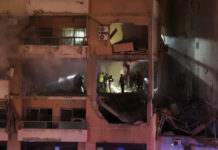CNN
—
A mysterious carbon monoxide leak at a Pennsylvania daycare sent dozens of children and staff to hospitals Tuesday morning, Allentown officials said.
Firefighters responded to a call about an unconscious child at the Happy Smiles Learning Center around 7:30 a.m., Allentown spokesperson Genesis Ortega said.
The firefighters’ carbon monoxide monitors alerted them to high levels of the odorless, colorless gas. Further investigation revealed “dangerously high levels” of carbon monoxide, prompting a full evacuation of the building, Ortega said.
Ambulances from multiple cities rushed to the scene, Allentown fire Capt. John Christopher said.
At least 27 children and staff were taken to hospitals by ambulance, Christopher said. Another five people from the daycare arrived at a hospital, possibly by private transportation, he said.
All 27 patients who were taken by ambulance were in stable condition, Ortega said. Another 25 children and staff were treated at the scene, she said.
Some of the 19 patients treated by the Lehigh Valley Health Network had been discharged by Tuesday afternoon, but some had high carbon monoxide levels that “required more aggressive treatment,” and were transferred to Hospital of the University of Pennsylvania and Children’s Hospital of Philadelphia, Andrew Miller, the head of pediatric Emergency Medicine at the network, said in a statement.
Some patients had as much as 10 times higher carbon monoxide levels than is “deemed normal,” Miller said.
The 17 children treated at the Lehigh Valley hospitals ranged in age from several months to 10 years old, Miller said.
The cause of the carbon monoxide leak is under investigation. As of late Tuesday morning, firefighters were still at the daycare trying to “mitigate the problem and ventilate the structure,” Ortega said.
More than 400 Americans die every year from unintentional carbon monoxide poisoning, according to the US Centers for Disease Control and Prevention.
Carbon monoxide can come from a variety of sources, such as gas stoves, generators and other gasoline-powered equipment, car exhaust, gas space heaters, fireplaces and gas water heaters, according to the U.S. Environmental Protection Agency.
Dangerous situations arise when people are in poorly ventilated, contained spaces where carbon monoxide is trapped, according to the Mayo Clinic. Carbon monoxide poisonings can happen when people try to use generators indoors after a power outage.
If there is too much carbon monoxide in the air that’s inhaled, the body’s ability to absorb oxygen can be diminished – resulting in serious tissue damage.
“It is important to provide quick treatment to replace the CO in the blood with oxygen as excessive inhalation of CO is associated with acute and long-term consequences, including damage to the brain and heart, which require a lot of oxygen,” Miller said.
Source : CNN














